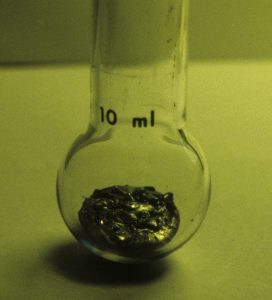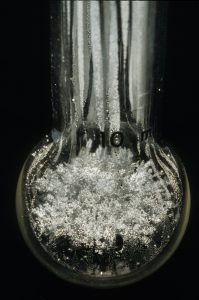Podcast episode
February 26, 2020
Episode 85: Introducing Alchemy with Lawrence Principe

We are honoured to interview Lawrence Principe, distinguished scholar of the history of science and a man who has made great alchemical discoveries in and out of the laboratory.
We discuss the etymology of the term ‘alchemy’, which tells us quite a bit about the transmission of alchemy down the ages, and then move on to the first known alchemical texts, the Pseudo-Democritan corpus (discussed in depth in the next episode) and what the possible forerunners of Democritus might have looked like. There are twin strands here: ancient metallurgical craft-traditions and Greek philosophical thought.
We then jump forward in time to our next great early alchemist, Zosimus of Panopolis. We discuss the paucity of the sources, the incredible mixing of traditions that went into Zosimus’ thought-world, and the general state of play in fourth-century alchemy in Egypt. We see no evidence of a Latinate alchemy in the classical period, but in the eastern Mediterranean enough material survives in Greek and Syriac to tell us that the art of Hermes continued to develop in the East Roman world into the middle ages. Our sole precious window onto the earliest Greek alchemy is through a small number of manuscripts, notably Marcianus Græcus 299 (whence the famous ouroboros pictured in the thumbnail to this episode), copied some time in the tenth century in an unknown East Roman scriptorium. Meanwhile, Islam arises in the seventh century, and, with the translation movement of the eighth century, we see a huge flowering of new directions in alchemical theory and practice in the Islamicate civilisation. From the twelfth century Latin authors begin to discover alchemy through translations of texts from the Arabic, and far-western alchemy is born.
We move on to the fascinating story of anti-alchemical currents: in the fourteenth century Latinate world, powerful people from the begin to question whether it is a good thing for alchemists to be practicing the art of making one metal look like another. This is an important matter for a state issuing a standard currency, for example. We then discuss the early-modern period, with its efflorescence of alchemical theory and practice and the emergence of ‘spiritual alchemies’ of various sorts alongside the majority, laboratory-based current. We discuss the emergence of chemistry as a distinct field of enquiry – a more complicated story than we have been taught in our Introduction to the History of Science classes over the years. Alchemy, understood as the pursuit of chemical transmutation, lives on until the nineteenth, and even in a few cases the twentieth century, in a complex love-hate relationship with chemistry. In fact, let’s assume that there are still active transmuters out there in the twenty-first century.
Having completed a superb historical overview of the development of alchemy from its Græco-Egyptian roots down to the modern era, we backtrack and address a few pertinent question, viz:
- To what degree is alchemy a unified field of enquiry in all its manifestations – or, conversely, to what degree are alchemists in different eras talking about radically different subject-matter?
- What are we to make of the many well-attested affadavits by educated people, sometimes trained metallurgists like Robert Boyle, claiming to have witnessed successful transmutation?
- What does the laboratory-work of a modern academic historian-alchemist look like?
- What is the deal with alchemical esotericism (the use of Decknamen, mysterious allegory, tropes of secrecy and concealment, &c. &c.)?
- When does the history of alchemy begin to get attention from serious historians of science (i.e. what is the history of the history of alchemy)?
Interview Bio:
 Lawrence Principe is Drew Professor of the Humanities and the Director of the Singleton Center for the Study of Premodern Europe at Johns Hopkins University. He has published widely on alchemy generally, early-modern alchemy in particular, and generally revolutionised the study of the subject by asking a simple question: What would happen if we actually tried alchemical recipes out in the lab? It turns out, a lot of interesting stuff happens!
Lawrence Principe is Drew Professor of the Humanities and the Director of the Singleton Center for the Study of Premodern Europe at Johns Hopkins University. He has published widely on alchemy generally, early-modern alchemy in particular, and generally revolutionised the study of the subject by asking a simple question: What would happen if we actually tried alchemical recipes out in the lab? It turns out, a lot of interesting stuff happens!
Works Cited in this Episode:
Primary:
- Boyle’s testimony to having witnessed a transmutation can be found at Principe 1998, pp. 264-269.
- Pope John XXII’s 1317 decretal against the alchemists: see Principe 2013, p. 60-2.
- Andrea Alciati’s 16th-century emblem books: see Principe 2013, p. 176.
Secondary:
- Louis Pauwels, Jacques Bergier, and Yvone Lenard. Le matin des magiciens. Harper & Row, 1967.
- Thorndyke 1923 (see below).
Recommended Reading:
The subject-matter of this episode is so sweeping that any attempt at a short bibliography will come up, well, short. We have put in some essential sourcebooks, some synoptic treatments, and a few books dealing with specific realms (e.g. Jewish alchemy, early-modern alchemy) likely to blow one’s mind.
Be sure to check out the research-project AlchemEast, which is doing much-needed cross-disciplinary work on the ‘lost centuries’ of ancient alchemy. Also, hard-core alchemy-heads will need these two multi-volume works before they can even get started:
- Marcelin Berthelot and C.E. Ruelle. Collection des Anciens Alchimistes Grecs, texte et traduction. G. Steinheil, Paris, 1887-8. [The primary edition for much of Greek alchemy.].
- Lynn Thorndyke. A History of Magic and Experimental Science During the First Thirteen Centuries of our Era. Macmillan, New York, NY, 1923. 8 vols. [an epic monument of scholarship, so thorough and extensive that, even though a lot of it is out of date, it remains an essential reference-work].
Also recommended:
- Allen G. Debus. The Chemical Philosophy: Paracelsian Science and Medicine in the Sixteenth and Seventeenth Centuries. Dover, Mineola, NY, rev. edition, 2002.
- Allen G. Debus, editor. Alchemy and Early Modern Chemistry; Papers from Ambix. Jeremy Mills, 2004.
- Carlos Gilly and Cis van Heertum. ‘Magia, alchimia, scienza dal ’400 al ’700: L’influsso di ermete trismegisto/magic, alchemy and science, 15th–18th centuries’. In Carlos Gilly, editor, Between Paracelsus, Pelagius, and Ganellus: Hermetism in John Dee, volume 1, pages 286–294. Centro Di, Florence, 2002.
- Jackson P. Hershbell. ‘Democritus and the Beginnings of Greek Alchemy’. Ambix, 34: 5–20, 1987.
- Bruce Janacek. Alchemical Belief: Occultism in the Religious Culture of Early Modern England. Pennsylvania State University Press, University Park, 2011.
- Jack Lindsay. The Origins of Alchemy in Graeco-Roman Egypt. Barnes & Noble, New York, NY, 1970.
- Bruce T. Moran. Distilling Knowledge: Alchemy, Chemistry, and the Scientific Revolution. Harvard University Press, Cambridge, MA, 2005.
- William R. Newman. Atoms and Alchemy: Chymistry and the Experimental Origins of the Scientific Revolution. University of Chicago Press, Chicago, 2006a.
- Idem. ‘Early Modern Science’. In From Alchemy to “Chymistry”, volume 3, pages 497–517. Cambridge University Press, Cambridge, 2006b.
- William R. Newman and Lawrence M. Principe. Alchemy Tried in the Fire: Starkey, Boyle, and the Fate of Helmontian Chymistry. University of Chicago Press, Chicago, 2002.
- Tara Nummedal. Alchemy and Authority in the Holy Roman Empire. University of Chicago Press, Chicago, 2007.
- Raphael Patai. The Jewish Alchemists: A History and Source Book. Princeton University Press, Princeton, NJ, 1994.
- Lawrence M. Principe. The Aspiring Adept: Robert Boyle and His Alchemical Quest: Including Boyle’s “Lost” Dialogue on the Transmutation of Metals. Princeton University Press, Princeton, NJ, 1998.
- Idem. ‘Transmuting Chymistry into Chemistry: Eighteenth-Century Chrysopoeia and Its Repudiation’. In José Ramón Bertomeu-Sánchez, Duncan Thorburn Burns, and Brigitte van Tiggelen, editors, Neighbours and Territories: The Evolving Idea of Chemistry. Proceedings of the Sixth International Conference on the History of Chemistry, pages 21–34. Memosciences, Louvain, 2008.
- Idem. ‘Alchemy Restored’. Isis, 102(2):305–312, 2011.
- Idem. ‘The Secrets of Alchemy’. Synthesis. University of Chicago Press, Chicago, IL, 2013.
- Meredith K. Ray. Daughters of Alchemy: Women and Scientific Culture in Early Modern Italy. Harvard University Press, Cambridge, MA, 2015.
- Pamela H. Smith. The Business of Alchemy: Science and Culture in the Holy Roman Empire. Princeton University Press, Princeton, NJ, 1994.
- Daniel Stolzenberg. ‘Unpropitious Tinctures: Alchemy, Astrology and Gnosis According to Zosimos of Panopolis’. Archives internationales d’histoire des sciences, 49:3–31, 1999.
- F.S. Taylor. ‘A Survey of Greek Alchemy’. Journal of Hellenic Studies, 50:109–139, 1930.
Gallery:
The following photographs were taken by Professor Principe. They document three stages of making a vegetative gold discussed in our interview.



Themes
Alchemy, Chrysopoeia, Decknamen, Esotericism, George Starkey, Hermes, Interview, Isma‘ilism, Occult Sciences, Overview, Philosophy, Pseudo-Democritus, Robert Boyle, Transmutation, Zosimus


Albert Hand
February 27, 2020
Where can I read more on this concept of learned play? Right now I’m working on a conference paper for the Association for the Study of Esotericism comparing play in Hypnerotomachia Polyphili and Atalanta Fugiens.
Earl Fontainelle
February 27, 2020
Doctor Hand, your paper-topic looks juicy.
Off the top, I don’t know of any scholarship on this subject. Anyone? You could certainly do worse than starting with Principe 2013, p. 176 ff., but I’m assuming you’ve already seen this.
Albert Hand
February 28, 2020
Hadn’t looked at Principe in awhile this helps, thanks! And thanks Stephen.
Stephen Rego
February 27, 2020
Hey Ted.
Here are some links and references you may or may not find useful in your research:
Donna Bilak,
‘Playful Humanism in Atalanta fugiens (1618),’ (2017).
https://italianacademy.columbia.edu/paper/playful-humanism-atalanta-fugiens-1618
Johann F.W. Hasler,
‘Performative and Multimedia Aspects of Late-Renaissance Meditative Alchemy: The Case of Michael Maier’s Atalanta Fugiens (1617),’ (Revista de Estudios Sociales. April, 2011).
https://dialnet.unirioja.es/servlet/articulo?codigo=3439874
Urszula Szulakowska,
Alchemy of Light: Geometry and Optics in Late Renaissance Alchemical Illustration’
Ch 5, pp. 64-65 – has an interesting discussion around Dee’s cabalistic emblem in the Monas Hieroglyphica.
György E. Szonyi
“Architectural Symbolism and Fantasy Landscapes in Alchemical and Occult Discourse: Revelatory Images,” in ‘Emblems & Alchemy,’ Alison Adams, and Stanton J. Linden, (eds.), (Glasgow Emblem Studies, 1998).
Stephen Rego
February 27, 2020
…and this one is may be of interest:
Lina Bolzoni,
“The Memory Theatre of Giulio Camillo: Alchemy, Rhetoric, and Deification in the Renaissance,” in ‘Lux in Tenebris: The Visual and the Symbolic in Western Esotericism,’ (Brill, Aries Book Series, Volume: 23, 2018).
James Lomas
February 27, 2020
1. Great new episode! I’ll admit that Christianity was starting to get overbearing. But, just to transition: were the gold, frankincense and myrrh in the Jesus story alchemical products, like those described in the Leyden Papyrus?
—
2. I am deeply concerned about the economy of the alchemical practice. How can it be focused on gold-making, which really doesn’t work very well, for hundreds of years?
If you ask me, that is not a great industry to be in. I get that astronomers could get paid for giving horoscopes, but if chemists are getting paid for trying to make gold, I don’t see the repeat business.
The practice of Alchemy, to the extent it could survive, must have been making chemical products of economic value.
I’m assuming they were making hard booze and other medicinals. And inks and poisons, etc etc. Alchemy can’t just have been the practice of trying to make gold!
Am I right to be concerned about the economic wellbeing of Alchemy practitioners, from 1-1700AD?
James Lomas
February 29, 2020
Column XXIX 169 of the Leyden Papyrus describes how frankincense and myrrh are used in a magical ritual help a young boy see and talk to the sun god. While I’m sure there are lots of other things that can be done with frankincense and myrrh, this is the first specific recipe I’ve come across involving young children.
Or maybe alchemists were involved in the manufacture of cheaper imitation frankincense and myrrh (in addition to imitation gold).
Earl Fontainelle
February 29, 2020
Maybe indeed.
As for children – this will maybe be of interest to those unfamiliar with ancient magic – the Greek magical papyri are full of children – especially virgin boys – to be used in a number of divinatory contexts. Seemingly, they were better at ‘seeing things’ on command than adults. I think this helps contextualise the sun-god recipe.
James Lomas
February 29, 2020
There is an ethical imperative at the end of the frankinsense and myrrh recipe — the one for seeing god:
“Its chief point is purity;
it is profitable for the boy, and it is profitable to you your-
self as a person (acting) alone.”
Lb Behrendt
July 4, 2023
this guest is the coolest guy in the world.
Earl Fontainelle
July 24, 2024
Pretty much.